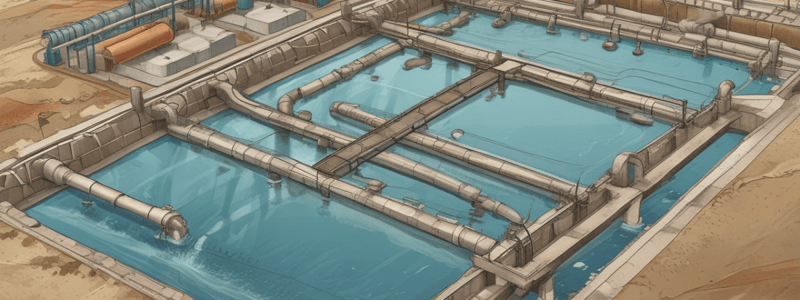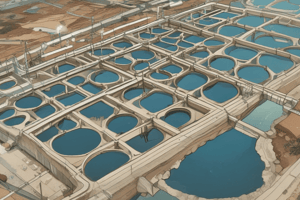Podcast
Questions and Answers
What is the term used to describe the flow of sanitary sewage in the absence of storms during the dry season?
What is the term used to describe the flow of sanitary sewage in the absence of storms during the dry season?
- Dry weather flow (correct)
- Stormwater discharge
- Rainwater runoff
- Wastewater surge
What percentage of water supply is expected to reach the sewers according to the text?
What percentage of water supply is expected to reach the sewers according to the text?
- 75%
- 80% (correct)
- 60%
- 90%
How is the maximum daily flow related to the average daily flow according to general assumptions in the text?
How is the maximum daily flow related to the average daily flow according to general assumptions in the text?
- $2 \times$ average daily flow (correct)
- $4 \times$ average daily flow
- $\frac{1}{2} \times$ average daily flow
- $3 \times$ average daily flow
What parameter is used in the conversion of contribution of wastes from industrial establishments for acceptance into sanitary sewer systems?
What parameter is used in the conversion of contribution of wastes from industrial establishments for acceptance into sanitary sewer systems?
What period is known as the future period for which a provision is made in the water supply scheme?
What period is known as the future period for which a provision is made in the water supply scheme?
What is used to express the strength of industrial sewage in relation to domestic sewage in terms of BOD5 content?
What is used to express the strength of industrial sewage in relation to domestic sewage in terms of BOD5 content?
What is one of the factors considered when estimating the design period for a sewage treatment plant?
What is one of the factors considered when estimating the design period for a sewage treatment plant?
Which method for population forecasting involves adding a fixed number of people to the population each year?
Which method for population forecasting involves adding a fixed number of people to the population each year?
What is a critical step in designing a treatment process in wastewater management?
What is a critical step in designing a treatment process in wastewater management?
Which type of screen is usually hand cleaned and sometimes provided with mechanical devices?
Which type of screen is usually hand cleaned and sometimes provided with mechanical devices?
What is the purpose of the bar screens with large openings provided ahead of pumps in sewage treatment?
What is the purpose of the bar screens with large openings provided ahead of pumps in sewage treatment?
What bar screen type uses perforated plates, woven wire cloth, or closely spaced bars with clear openings of less than 20 mm?
What bar screen type uses perforated plates, woven wire cloth, or closely spaced bars with clear openings of less than 20 mm?
How does the velocity of flow through the screen impact its operation?
How does the velocity of flow through the screen impact its operation?
What is one consideration when determining the design velocity for screens in sewage treatment plants?
What is one consideration when determining the design velocity for screens in sewage treatment plants?
How does head loss vary with the quantity and nature of screenings allowed to accumulate between cleanings?
How does head loss vary with the quantity and nature of screenings allowed to accumulate between cleanings?
Flashcards are hidden until you start studying
Study Notes
Wastewater Quantity Estimation
- Dry weather flow (DWF) is the flow of sanitary sewage in the absence of storms in dry season.
- DWF is calculated as: Quantity = Per capita sewage contributed per day x Population.
- Sanitary sewage is mostly spent water of the community draining into the sewer system, with 80% of water supply reaching the sewers.
- Fluctuations in DWF occur due to variations in water consumption, with maximum daily flow = 2 x average daily flow and minimum daily flow = 2/3 x average daily flow.
Population Equivalent
- Population equivalent is a parameter used to convert industrial waste contribution into sanitary sewer systems.
- It is calculated as: Std.BOD5 = (Std.BOD5 of domestic sewage per person per day) x (population equivalent).
Design Periods & Population Forecast
- The design period is the future period for which a provision is made in the water supply scheme, usually 5-10 years excluding construction period.
- Population forecasting methods include: Arithmetic Increase Method, Geometric Increase Method, Incremental Increase Method, Decreasing Rate of Growth Method, Simple Graphical Method, Comparative Graphical Method, Ratio Method, and Logistic Curve Method.
- The selection of a method depends on factors such as useful life of components, expandability, anticipated population growth, available resources, and system performance during the initial period.
Wastewater Characterization
- Wastewater characterization is a critical step in designing a treatment process, with important parameters including:
- Temperature
- pH
- Colour and Odour
- Carbonaceous substrates
- Nitrogen
- Phosphorous
- Chlorides
- Total and volatile suspended solids (TSS and VSS)
- Toxic metals and compounds
Types of Screens
- Coarse Screens (bar screens):
- Composed of vertical or inclined bars spaced at equal intervals across a channel
- Bar screens with large openings (75-150 mm) are used ahead of pumps, while smaller openings (50 mm) are used ahead of sedimentation tanks
- Hand cleaned and sometimes provided with mechanical devices (rakes)
- Medium Screens:
- Clear openings of 20-50 mm
- Bars are 10 mm thick on the upstream side and taper slightly to the downstream side
- Fine Screens:
- Mechanically cleaned devices using perforated plates, woven wire cloth or closely spaced bars with clear openings of less than 20 mm
- Not normally suitable for sewage due to clogging possibilities
Screen Operation
- Velocity of flow ahead of and through the screen varies and affects its operation
- Lower velocity through the screen allows for greater removal of screenings, but increases solids deposition in the channel
- Design velocity should permit 100% removal of material of certain size without undue depositions
- Velocities of 0.6-1.2 mps through the open area for peak flows, and 0.3 mps at low flows in the approach channel, have been used satisfactorily
- Head loss varies with the quantity and nature of screenings allowed to accumulate between cleanings
Studying That Suits You
Use AI to generate personalized quizzes and flashcards to suit your learning preferences.





